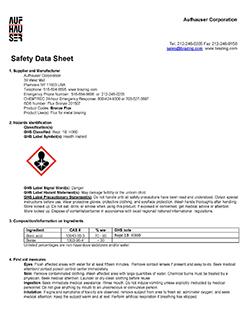BronzeFlux
REFERENCES
Flux Selection ChartDESCRIPTION
For brazing brass, bronze, copper, steel, nickel silver, and malleable iron, Aufhauser BronzeFlux is the most efficient brazing flux on the market and also the most economical. BronzeFlux causes the bronze to penetrate deeper into the joint, making a stronger union than is possible with other fluxes. Bronze Flux #22 keeps the impurities and porosity out of the bronze welds. It dissolves and removes oxides rapidly and thoroughly without bubbling.
DIRECTIONS
Thoroughly clean the work piece; breaks should be enlarged to a V-notch. Heat the end of the welding rod with a torch and dip into the flux, or the flux may be sprinkled on the work. Continue to melt filler rod until the break or joints is filled, but avoid over hearting. At the right temperature flux will turn into a liquid that rapidly flows into every crack and crevice of the work piece, removing impurities, dirt and oxides. The flux acts as a true cleansing agent, allowing the bronze filler rod to make a tenacious joint. If properly done, only the filler rod is melted, not the parent metal.
This flux may also be used as a paste by dissolving one part of flux in two to four parts of clean water. Make a paste of thick, creamy consistency, stirring the flux vigorously in the water. Brush the paste on the work piece, completely covering the area to be brazed, and also on the brazing rod. Allow paste to dry. Heat area to be welded to a cherry red, apply the fluxed rod, and melt the rod until the break or joint is filled. The work piece and the rod can be prefluxed and set for brazing later.
PROPERTIES
- White, granular solid, fairly dustless, with slightly greasy or soapy feel.
- Boric acid equivalent - 96.5%
- Stable at ordinary temperatures. When heated above 100°C, it gradually loses water, changing to metaboric acid. On continued heating all water is lost and the anhydrous oxide B203 is primarily formed.
ADDITIONAL INFORMATION
BronzeFlux is not to be absorbed through intact skin areas. Do not ingest. Absorption will produce pathological disturbance. Respiratory protection should be worn in heavy dust concentrations. |

